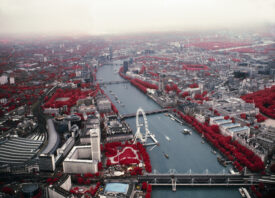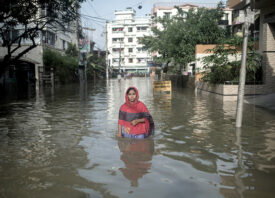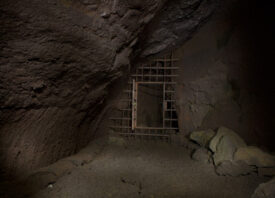Search this site
Magical Photos from an Isolated Community in the Forests of India



“A long time ago, a flood swept away orphan siblings Lecha and Secha’s village in the mountainous landscape that is now Namdapha National Park & Tiger Reserve,” the New Delhi-based photographer and academic Sharbendu De tells me. “Before the flood came, a bird advised them to hide into a cave and seal its mouth. The flood washed everything away. As the sole survivors, they came out of the cave, but they did not find anyone. They traveled for years in separate directions searching for other survivors.”
He’s recounting a folktale from the Lisu tribe, a group of people who have lived on this remote expanse of land in Arunachal Pradesh, India, close to the border with Myanmar, for generations. The story ends when Lecha and Secha have reached old age. They’ve spent their lives seeking others, and at last, they wind up back where they started. Their paths meet, and recognizing that they are alone, they ask God for permission to wed and start the human race anew.
De sees the tale as a kind of metaphor for the real-life stories of Lisu tribe members in India, who live secluded in the dense forest. Though they are Indian citizens, the Lisu people have experienced decades of isolation, oppression, and loss. In 1983, their ancestral land was converted into a national park without their consent. “They were declared poachers and encroachers of the land and evicted on occasions,” De writes. “But they always returned to the forests.” Since then, they have survived without access to basic human rights like healthcare and education. Because the forested area is so cut-off from nearby towns and cities, they pay inflated fees for oils, spices, and medicines that must cover great distances to reach them. A journey to the nearest town takes three to six days of arduous trekking. As the photographer puts it, “Life is expensive, and death is cheap.”
De first met members of the Lisu tribe in 2013, and he has since had three extended trips to the area. When he’s there, he lives alongside the people he’s photographing, often for months at a time. Over the years, he’s found a dear friend in David Yobin, a man from one of the villages, described by the photographer as “the most humble and compassionate human being I’ve ever met.” He’s watched as David’s boys have grown and matured, and he’s also seen David take on the roles of school teacher and doctor for the community in the absence of government support.
De has taken an unconventional approach to telling the story of the Lisus; since the birth of photography, oppressed communities have been cast as “exotic” or “primitive” by those standing behind the camera. Instead of taking a “colonial-anthropological” look at these families and individuals, he’s chosen something closer to magical realism. The photographs themselves are rich with symbolism, and the Lisus’ animals and their environment become key characters in the narrative. If pure photojournalism is prose, De says his work is poetry. He makes sketches before constructing an image, and sometimes he’ll elevate the mythical atmosphere of a scene by adding elements like fog.
Although he has used a more documentary approach in past chapters of the ongoing project, he describes the images shown here as “entirely fictional.” But I’m not sure if that’s quite right; of course, the scenes are “staged,” but like any other dreamworld, this one holds subconscious truths. While he hasn’t recorded daily Lisu life, De has captured the essential and intangible qualities he’s observed in his Lisu friends. His pictures are a testament to the Lisu people’s relationship with nature, their gentle stewardship of their animals, and their ability to find light in darkness. De feels drawn to the story of Lecha and Secha because of their loneliness, and his images do reflect that sense of isolation, but perhaps it’s equally important to remind ourselves that Lecha and Secha did find each other in the end. And they saved the human species. More than anything, I see De’s images as a tribute to the bonds if Lisu families–to the mothers, fathers, sisters, and brothers who, in trying times, find strength in each other’s arms.
As a photographer and a writer, De thinks often about the wider implications of his work. Ethics figure heavily into his decisions. He tells me, “I keep asking myself, ‘Why represent these tribal people with this creative fictional aesthetic when a documentary approach can show their immediate reality, suffering, etc.?'” In the end, he feels other avenues have failed to honor and respect marginalized communities. Instead of asking us to look at the Lisus for their differences, he hopes we’ll consider their history, their despair, and their grace within the context of our own dreams, hopes, and imaginations. We asked him to tell us more about his ongoing project Imagined Homeland, which is supported by an Art Research grant from India Foundation for the Arts and Titan Company Limited. Imagined Homeland is on view at the Indian Photography Festival in Hyderabad this month and will also be on view as part of the Tbilisi Photo Festival in Georgia.

Why do you think these people chose to trust you with their stories?
“Nobody from the media ever goes there; after all, how many would trek hundreds of kilometers, risk their safety and equipment, and invest weeks or months into a story that’s not even sensational? Perhaps they partly trusted me because I was the only option they had; but more than that, it’s the relationship that has grown over the last six years.
“I carried copies of the stories I had done on them and shared them with the Lisu tribal leaders and the community. That worked as tangible proof. Word spread slowly into neighboring villages, and soon, many knew that I’d returned. I explain my intentions and engage intensely without compromising on journalistic integrity. I have carried modest medicine kits with me and handed them over to David for his village. The bond that we have built together has helped me earn their trust, but it isn’t easy.
“There are many who still suspect me of being a forest department official, thus creating resistance. They have been ignored and exploited for so long that it’s difficult for them to trust outsiders. While it’s annoying, I empathize with them. I believe that if your intentions are honest and you treat your subjects with empathy and not as objects, they sense that sincerity. That starts to open doors.
“The most recent time I walked into Gandhigram Village (the biggest Lisu village), a Lisu man told everyone, ‘This is a good man, and he has come to help us.’ His word influenced others, and he also helped me and eventually participated in a portrait I made of him and his daughter in the forest. Since I was struggling with the extreme cold without a proper house or comforts, he lent me his quilt so that my assistant and I could survive comfortably. That little gesture was a huge help because I was struggling with severe body and back aches after sleeping on a bare floor for weeks.”

What stories did you hear from these families about their experiences?
“David once told me, ‘Each year, about 20 people in Aguhum Village die due to the lack of treatment.’ I have seen a lot of death and suffering over my years of photographing natural disasters in South Asia, but I struggle to fathom that how a community that has lost so much can still have so much kindness to offer. This thought has been a primary driver for me continuing on this path to understand their mythical nature.
“They are also funny ones. David is 55 years old but chuckles like a boy. In the evenings, we’d huddle around the fireplace, and he’d narrate folktales about cats and buffaloes and Lisus. Once he shared an anecdote about an old man who went around asking about the number of days it would take him to walk up to Kashmir so that he could fight the Pakistani Army during the Kargil War (1999). On the radio, he had heard that Indian soldiers were being killed, and he wanted to avenge their deaths.
“This is ironic yet painful; he had never seen vehicles and thus could not imagine hiring a vehicle to reach Kashmir, and despite the fact that the country had given them nothing, he was still pained by the loss of young Indians.”

Has the situation changed for the Lisus since the establishment of Namdapha National Park in 1983? Has the government offered any solutions?
“No! The government has offered toothless rehabilitation and relocation packages on land belonging to another tribe. Traditional tribal wisdom amongst the mountain tribes of Arunachal Pradesh and other parts of India advise each tribe to live distances apart to avoid conflicts. The government has done nothing to help or assist them in alleviating their sufferings but has left them to live and die there.
“In the 1970s, plans for a 157 kilometer arterial MV Road were made so that the bordering villages could be connected. To date, there exists only an endless stretch of mud and slush. No buses or vehicles can commute. There are no schools, hospitals, electricity, phone networks, or any of the services that the Indian government is mandated to provide for its citizens. Meanwhile, the Lisus die without treatment, and their children grow up without schools and education. The exceptional quality of the Lisus is that they have started treating their sick and teaching their children instead of resorting to protest and violence. They are deeply anguished, and yet they remain gentle.”
Can you tell me more about the relationship between the people and their land? How does it differ from the way the government treats and interacts with the same land?
“For the government, the land is an economic and environmental resource, but it’s an entirely transactional power game without any real concern for the inhabitants of the land. They take a colonial approach.
“For the Lisus, this land is where their ancestors came and made new homes after they migrated from Myanmar before India and Myanmar created the international border. They made homes in the absolute wilderness, miles away from any outside human activity. They grow up, live, and die in these forests. Their attachment to the land is very strong.
“They do not believe that the land belongs to an individual but to God; only the produce from the land may be taken and shared, without a sense of individual property. This is why you won’t see fences between different families’ land in the forests, though everyone knows which land is used by whom. That rare traditional knowledge can come only with the inheritance of ancestral values, local lore, and a strong community bonding. They sustainably extract forest produce, and they are acclimatized to the heavy monsoons and freezing winters. Despite the hardships, they refuse to leave this place –– they call it home.”

What do you hope people within the tribe see when they look at your images?
“I’d like them to see compassion and care. I hope that the Lisus can see a representation of their inherent qualities when they look at these images. There is a risk because these cinematic but fictional images are a stretch of the imagination, removed from their immediate daily reality, but time and again, I have to remind myself that they are not the key audience of this work. They are my collaborators, part of the extended storytelling team, and together, we are trying to communicate their stories of love, longing, and loss. But our audience is outside the forest, and this work is intended to stimulate their sensibilities so that the outside world acknowledges their existence and pain.”

What have you learned from your time with the Lisus?
“I will share a summary of the lessons that life has offered here. I had to live in extreme hardship without roads, basic comforts, access to family or friends to talk to, medical aid, etc. I trekked for days, risked accidents, suffered from unbearable physical and emotional pain after lugging 15-20 kilograms of gear and supplies for about 27 kilometers in a day. I did not get a soft bed at night, and I spend months literally under darkness with a teeming solar lamp.
“When you live in these circumstances, thoughts of larger things cease. The immediate problems frustrate you and break down your ego. Slowly, they drill a sense of humility into you. When you crane your head up to look at the sky, you find a whole new world waiting for you. This resonates with some of the friends I made there, who, despite the challenges, still dare to dream of a better life. At the same time, they’re happy.
“I hope I never forget that true and lasting happiness may be found in living together like the Lisus do. I plan to return there at the end of this year again and spend another couple of months with them, hopefully complete the work and start working on a photo book. I hope new lessons and memories are waiting.”

What can the public do to help?
“More than money, it’s important for the Lisus to start to feel that the world hasn’t completely forgotten them and that we care. Such gestures can serve as a bridge and be so very meaningful.
“I recall one incident where a whole village, Aguhum (David Yobin’s village), had no medicine left in their stock, and several people, especially children, were falling sick. Two children were very unwell, and one child almost passed away. I witnessed and made photos of those crisis moments. I had brought a medicine box with me, sent by a couple of friends of mine. David and I took the kit and went to see the family in the night. David attended to the child while I made photos. The next day, the child was a little better. The family came down to see us the next morning with a dozen eggs as gifts to express their gratitude.
“To get involved, feel free to write to Avia Fisher of Yobin Tribe Fundamental Rights Forum (YTFRF) at [email protected]. Avia is the lead activist fighting for the rights of the Lisus (the Lisu tribe is known as Yobin in India), and he is one of the chief negotiators with the Government of India on the subject.
“Avia is also the first person to write a dictionary in the Lisu language. He is presently working on another dictionary that will help the Lisus learn words and phrases so that they can communicate better with outsiders. The work is very important as it will serve as an intellectual bridge, and he could use some funding to print the dictionary. Viewers can also write to me directly at [email protected], and I can point them in the right direction, depending on how they would like to help or be involved.”

All images © Sharbendu De



